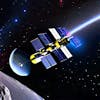S03E22: Eclipse Enchantment & Celestial Mechanics: North America's Solar Spectacle & Moon's Hidden History

**Hosts:** Anna and the Astronomy Daily Team
---
**Episode Summary:**
Embark on a cosmic odyssey with Anna and the Astronomy Daily Team as we delve into the latest astronomical phenomena and space exploration marvels. Today's episode is a celestial...
**Hosts:** Anna and the Astronomy Daily Team
---
**Episode Summary:**
Embark on a cosmic odyssey with Anna and the Astronomy Daily Team as we delve into the latest astronomical phenomena and space exploration marvels. Today's episode is a celestial tapestry woven with the enchantment of a total solar eclipse, Russia's soaring space ambitions with the Angara A-5, and the intriguing partnership between China and Thailand on lunar exploration. We'll also grapple with the enigmatic 'Flying Fox' plasma cloud and unravel the mysteries of the moon's uneven geology. So tune in, and let your imagination soar across the universe as we uncover the stories that connect us to the cosmos and each other.
---
**Featured Topics:**
1. **Eclipse Over North America:** Relive the awe of the total solar eclipse that united people in wonder, as darkness swept across the continent and the sun's corona captivated millions.
2. **Russia's Angara A-5 Launch:** Witness the power of Russia's latest space endeavor as the Angara A-5 rocket prepares for a historic lift-off, signaling a new era in the nation's cosmic pursuits.
3. **China-Thailand Lunar Collaboration:** Discover the groundbreaking partnership that propels China and Thailand into the lunar limelight, contributing to the international lunar research station with innovative space weather technology.
4. **The Mystery of the 'Flying Fox':** Dive into the perplexing discovery of a magnetized plasma cloud that challenges our understanding of astrophysical phenomena and the tools we use to observe them.
5. **The Moon's Asymmetrical Secrets:** Explore the latest theories that explain the moon's lopsided geology, revealing a dramatic past of magma oceans and titanic impacts that shaped our celestial neighbor.
---
**Additional Information:**
For a continuous exploration of the cosmos, visit astronomydaily.io to access our extensive episode archive and immerse yourself in the beauty and complexity of space science. Engage with fellow enthusiasts and the Astronomy Daily Team by following @astrodailypod on X. Together, we'll keep the cosmic conversation alive and the passion for the stars burning bright.
---
**Closing Remarks:**
As we conclude this interstellar journey for today, we thank you for joining us in celebrating the boundless beauty and intrigue of the universe. Keep your eyes on the skies and your heart open to the endless possibilities that lie within the stars. This is Anna, bidding you farewell, but not goodbye, on the Astronomy Daily podcast.
---
**Host Sign-off:** Anna: "Thank you for sharing this celestial adventure with us. Until we meet again in the vast expanse of space, this is Anna, signing off. Keep dreaming, keep discovering, and always reach for the stars!
📋 Episode Chapters
(00:00) Astronomy Daily brings you the latest news from astronomy and space exploration
(00:45) A total solar eclipse swept North America on August 21
(04:45) China and Thailand sign memorandums of understanding to collaborate on lunar missions
(06:49) Radio telescope reveals mysterious cloud of magnetized plasma in Hydra galaxy cluster
Become a supporter of this podcast: https://www.spreaker.com/podcast/astronomy-daily-the-podcast--5648921/support.
For more visit www.astronomydaily.io
This episode is brought to you with the support of NordPass....the password manager you really need in your life. Check out our great deal for you at www.bitesz.com/nordpass
AI Transcript
Astronomy Daily brings you the latest news from astronomy and space exploration
Anna: Welcome to Astronomy Daily, the podcast, your source for the latest chatter in the cosmos. Today, we bring you a series of captivating news from the world of astronomy and space exploration. Prepare to be spellbound by celestial events, pioneering missions, and groundbreaking discoveries. Whether you're an amateur astronomer or a seasoned space enthusiast, the stories we've lined up are sure to ignite your imagination and deepen your awe for the infinite dance of the universe. So adjust your telescopes and sharpen your senses. We're about to embark on an interstellar journey that traverses solar eclipses, ventures into new frontiers of spacefaring nations, and unveils the mysterious workings of our celestial neighbor, the moon.
A total solar eclipse swept North America on August 21
Stay tuned as we decode the wonders of the night sky and beyond execution or your experiment, the astronomy Daily podcast a sense of wonder enveloped North America as millions looked scarce skyward, bearing witness to the grandeur of a total solar eclipse. This celestial dance where the moon cloaked the sun, unfolded a spectacle rarely paralleled in its marvel. From Mexico's Pacific coast plunged into darkness, to the awestruck crowds along the eclipse's path of totality, across the United States and Canada, the corona of the sun, an ethereal halo, emerged from behind the moon's silhouette, seizing the day and turning ordinary moments into the extraordinary. Joy and curiosity brought communities together. Festivals erupted, people from all walks of life connected in shared amazement, and myriad events like mass weddings, became backdrops to a sky that played canvas to the cosmic ballet. In places like Montreal, office workers leaving their high rises became part of a grand congregation, all equipped with eclipse glasses, turning a regular day into a communal embrace, with the cosmos echoing down from Mazatlan, Mexico, where the eclipse first graced the continent, revelers cheered and marveled, capturing the event both in their hearts and on their cameras. This was not just an exhibition of cosmic phenomena, but a testament to human spirit, the boundless enthusiasm that astronomy incites. It was a day when national divides faded under the unifying dark shadow of the moon, when even the president of the United States humorously reminded us to heed the wisdom of scientists as we gaze upwards. As the eclipse etched its path across the continent, it became clear this was an intimate encounter with the vastness of space, a rendezvous with the awe inspiring mechanics of our solar system. And as night turned today, in under 90 minutes, it would stand as a reminder we're not just observers of the universe. We are part of its magnificent tapestry. Russia's ambitious strides into the cosmos have always been hallmarked with grand gestures of technological prowess, and the Angara a five is no exception. The Vostokny cosmodrome, set deep in the tranquil forest by Russia's far east, is the latest symbol of Moscow's quest for space supremacy. Amidst a history laden with delays and corruption complications, this freshly minted launchpad is the stage for the Angara a five rocket's maiden voyage into the great beyond. This launcher, stretching an imposing 42.7 meters and capable of lofting payloads in excess of 20 tons, marks a pivotal transition for Russia, the dawn of replacing the venerable proton m um heavy lift rocket that has graced the skies since the mid 1960s. The importance of the Angara a five cannot be overstated. It is a tangible representation of Russia's space endeavors, echoing President Vladimir Putin's sentiments on its critical role in national security. But the journey to this precipice has been no straightforward feat. The Angara a five has experienced its own share of manufacturing hurdles and technical trials. Now, nearly a decade since its inaugural test flight from the northern Plesetscu Cosmodrome, the rocket stands poised for a trial by fire. If successful, this launch could pivotally anchor Russia's position in the competitive narrative of space exploration and its future trajectories, both terrestrial and interstellar. It's a moment of collective breath holding as we await the countdown to ignition, slated for midday Moscow time. The air is teeming with expectation and the unspoken weight of past achievements and upcoming prospects. The Angara a five launch from Vostochny could very well be the cornerstone upon which the next chapter of Russia's cosmic ambitions is built. A tale of resilience, innovation, and the undying human spirit in pursuit of the stars.
China and Thailand sign memorandums of understanding to collaborate on lunar missions
As we cast our gazes to the horizon of lunar exploration, an exciting new chapter unfolds with the partnership between two nations, China and Thailand. This collaboration, marked by the signing of two memorandums of understanding in Beijing, paves the way for a leap in the exploration and peaceful use of outer space. Together, these nations are set to contribute to the ambitious international lunar research station. China's upcoming Chang seven lunar mission, earmarked for launch circa 2026, will carry a groundbreaking addition, a global space weather monitoring device developed by Thailand. This scientific instrument is poised for a historic journey as it will break new ground for Thailand's space technology, venturing into deep space from Earth orbit to unearth secrets from a unique lunar vantage point. Looking further ahead, China's Chang'e eight mission, slated for approximately 2028, opens its payload bay to international cooperation amongst the contenders. Thailand's lunar surface operation, robots and scientific payloads stand their applications currently undergoing rigorous selection processes. But this partnership extends far beyond individual missions. It signifies a firm commitment to shared learning and development in space exploration. Both countries aim to deepen their cooperation through joint space projects, scientific exchange programs, and comprehensive data sharing, with an eye on the overarching goal realizing the international lunar research Station. China and Thailand invite other nations, organizations, and researchers to join this open invitation to contribute to a collective human endeavor on the moon's surface. It's a remarkably collaborative time for space exploration, where boundaries on Earth give way to boundless curiosity and shared aspirations. On the lunar landscape, keep watching the skies as the cooperative spirit between China and Thailand fuels innovation and ignites the dream of extending humanity's reach beyond our celestial neighbor. The astronomy daily podcast.
Radio telescope reveals mysterious cloud of magnetized plasma in Hydra galaxy cluster
High above us, in a dance of cosmic forces, a mystery has cast its silhouette across the vast canvas of space. In the Hydra galaxy cluster, astronomers have been left puzzled by an inexplicable cloud of magnetized plasma. Like an interstellar enigma, this phenomenon has been named the flying fox, not after the creature it resembles, but for the bewilderment it instills in those who observe it. The flying fox was unveiled through the discerning eyes of radio astronomy. Detected by the sensitive instruments of the giant meter wave radio telescope, this discovery challenges our understanding. As the cloud's peculiar location and shape seem to break the mold of any known astrophysical objects, the flying fox does not offer the comfort of familiarity. It has no apparent host galaxy at its center, an oddity in itself, and its elongated silhouette stretches out, mocking conventional explanations. Astronomers are working feverishly to piece together this puzzle. The newfound plasma cloud, invisible to optical and x ray telescopes, remains visible only to the radio gaze. Like a whisper in the chorus of the universe, it echoes the cutting edge advancements in technology and the increasing acuity of our astronomical tools. As we stand on the brink of discovery, with the square kilometer array poised to bring the flying fox into sharper focus, we are reminded of the depths of our curiosity and our, uh, relentless pursuit of knowledge. The space between stars may seem empty, but it is spaces like these where new stories begin waiting to be told. Unraveling the mysteries of the moon has been a pursuit of astronomers and scientists ever since we cast our gaze to the night sky. Today, we've turned a page on a perplexing chapter regarding the moon's lopsided geology, with researchers uncovering new theories that shed light on our satellite's turbulent past. The story of our moon's birth is a celestial drama, a molten aftermath of a colossal impact between the Earth and a mars sized body. Through the intense heat and energy of this cataclysm, the moon emerged first as an ocean of magma. And gradually, over eons, it cooled and solidified. A curious phenomenon remained, an asymmetry that set the two halves of our moonworlds apart, literally. Rocks collected by Apollo astronauts hinted at the imbalance, revealing an unexpected abundance of titanium rich minerals, predominantly on the moon's near side. And it was only through relentless investigation that scientists pieced together the puzzle. Imagine the young moon's surface coated in a slurry of fireborne minerals. Among these denser minerals, like ilmenite, loaded with titanium and iron, awaited their descent into the lunar mantle. The question was, how did this happen? Scientists now propose that gravitational instabilities generated by these dense, heavy materials led to their dramatic sinking, turning the moon's insides quite literally inside out. As these minerals plunged into the depths, they mixed, melted, remapped the lunar mantle, and re emerged millions of years later, painting the near side surface with titanium rich lava flows. And then there's the role of the Grail mission. NASA's duo of spacecraft, with their precise gravitational mapping, unearthed linear anomalies beneath the moon's crust, aligning neatly with simulations of sinking ilmenite rich layers, a labyrinth of dense underground formations bearing the legacy of the moon's formative years. Add to this narrative a cosmic twist. The moon's surface features betray the timeline of these events. The largest impact basins formed by ancient collisions mark a time before this inner turmoil occurred, cementing a chronology that speaks to the moon's violent youth. With these revelations, our, uh, understanding of the moon extends beneath its quiet, cratered visage, revealing a dynamic history of motion and metamorphosis. These findings don't just rewrite lunar history. They echo across our solar system, impacting theories about the formation and development of terrestrial planets like Earth and Mars. As we continue to probe and question the moon, Earth's eternal companion offers up answers to age old queries about the very fabric of our cosmic backyard. As our journey across the stars comes to an end. For today, we invite you to visit astronomydaily IO for our archived episodes and to dive deeper into the awe inspiring universe of space science, delve into the intricacies of celestial phenomena, and revisit some of the most intriguing stories we've brought you. Follow us on X, formerly Twitter astrodailypod, to join our community of stargazers and cosmophiles. There, we continue the conversation, sharing the latest discoveries and the timeless wonders of the cosmos. Until next time, keep looking up and let your curiosity be as boundless as the universe itself. This is Anna, your host, saying bye bye, the astronomy daily podcast.
New to Astronomy Daily - The Podcast?
Here are some great episodes to start with.














